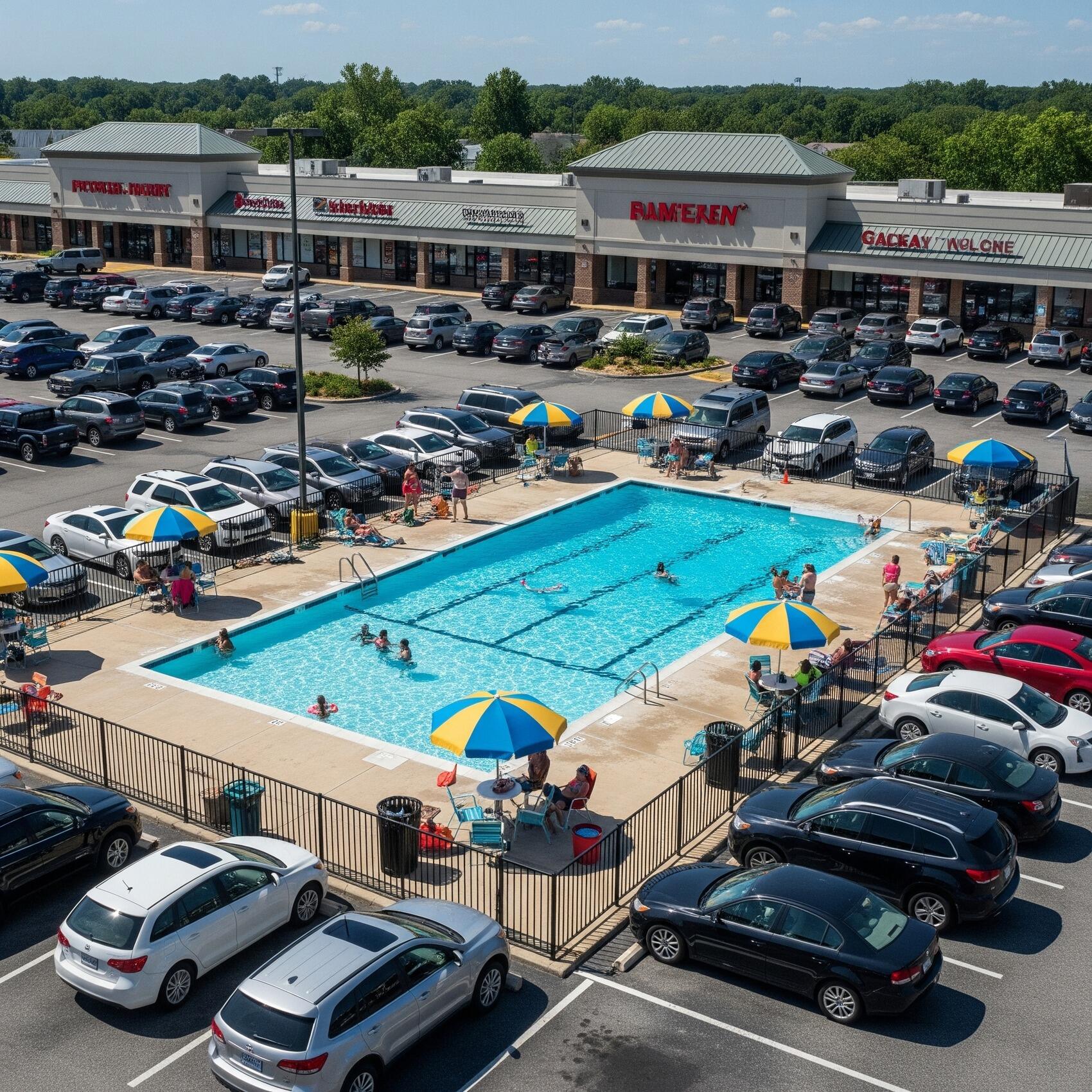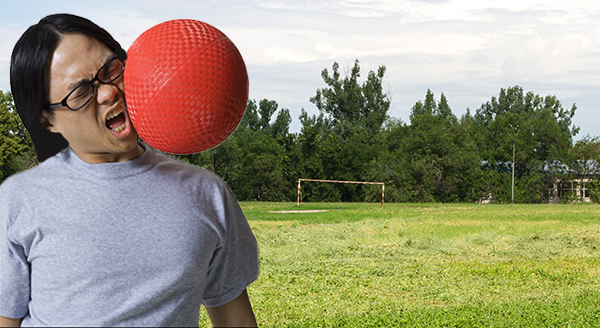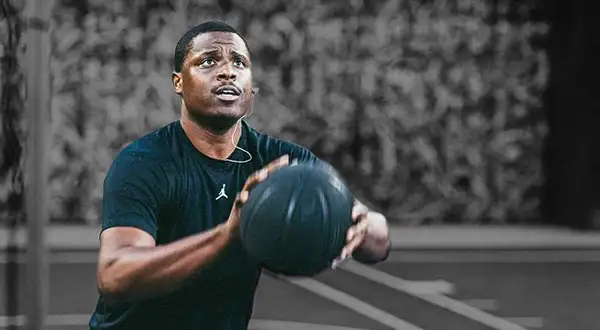The new sound of summer in America is pwock — the collision of a plastic ball and fiberglass-covered paddle repeated hundreds of times an hour at city parks, country clubs, and retirement communities.
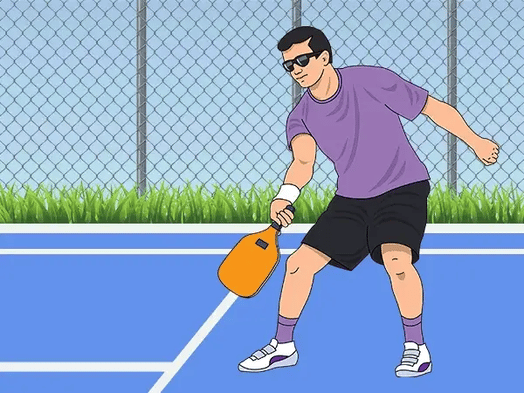
For pickleball players, pwock is glorious. It’s the sound of a solid hit, an auditory cue that means you’re having fun, competing, and maybe even getting revenge on that pompous high school P.E. teacher who once tormented your class with his crafty pickleball skills (although that last part might just be me).
Once a niche sport for retirees (and oddball P.E. teachers), pickleball has exploded over the last decade. Last year, 8.9m Americans played pickleball regularly, while another ~27m played at least once, making the sport nearly as popular as running.
But many people living near the pickleball courts, however, have a knock with the pwock.
- North Berkeley, California, apartment dwellers have moved out over the game’s unrelenting noise.
- A suburban Kansas City couple filed a lawsuit against an adjacent country club, alleging that the “repetitive nuisance” of pickleball woke them up at 6am.
- In New Jersey, a blogger described a community’s decision to close noisy pickleball courts as a declaration of war.
“It’s touched a nerve, literally, around America,” said Robert Ducharme, a New Hampshire attorney who has advised homeowner associations and condo groups on pickleball. “It’s becoming more and more of an issue.”
In this maelstrom of neighborhood squabbles, lawsuits, and court closures, objective data and advice have been hard to come by. Hardly anyone has considered how to make the game quieter.
Enter Bob Unetich, a retired engineer and Carnegie Mellon University professor and founder of Pickleball Sound Mitigation LLC. He’s become a go-to source for information (and diplomacy) in the pickleball wars, studying everything from paddles to the placement of courts.
If America starts hearing fainter pwock sounds, it might just be because the sport started listening to Unetich.
Louder than tennis
Unetich, 77, got into pickleball in 2013 after buying a retirement condo with his wife in Bonita Bay, Florida. They believed they’d be spending their retirement on the water, but every time Unetich went to the marina, neighbors asked if he wanted to play pickleball.
He quickly became an avid player, a certified referee for national events, and somebody obsessed with the details of the pwock sound.
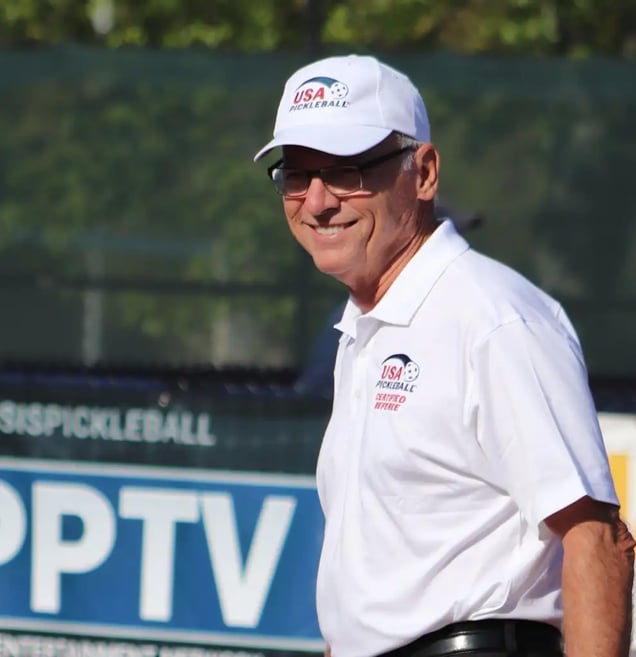
Bob Unetich at a pickleball match. (Courtesy of Unetich)
Pickleball, it turns out, is an unusually loud sport.
- When the hard surface of the pickleball racket connects with the hard surface of the ball, sound waves vibrate rapidly, registering a decibel level of ~70 dBA at 100 feet from the court. (Tennis is closer to 40 dBA.)
- Although a solid hit reaches 70 dBA, the average noise level throughout a typical pickleball match (which features lighter hits and moments of silence between hits) is ~59 dBA, according to a research paper co-authored by Unetich. That number increases when multiple courts are packed next to each other, as is often the case.
- Pickleball hits also have a high pitch, with a frequency of ~1.2k Hz, which is roughly the same frequency as the beeping noise from a garbage truck backing up.
“The most annoying of all frequencies,” Unetich said. “It catches your attention.”
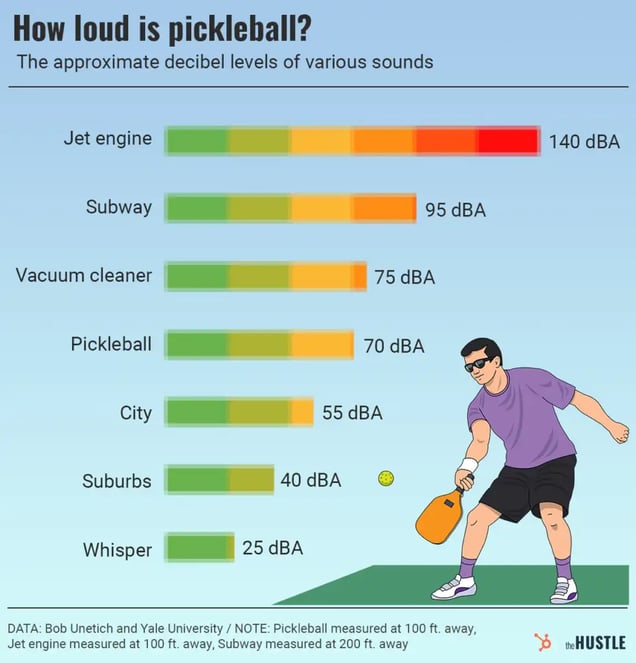
The sound of pickleball grew incessant at Bonita Bay as the number of regular players increased from a handful to more than 300. An acoustics firm installed heavy vinyl over a chain-link fence surrounding the courts, but that merely reflected the sounds.
So Unetich helped research a solution of adding an absorbent fiberglass material. Other Florida communities followed the Bonita Bay model, and pickleballers started calling him for advice.
Sensing the demand, he founded Pickleball Sound Mitigation LLC in 2021, bringing in retired acoustical engineers Barry Wyerman and Dale Van Scoyk.
- The company has since consulted for more than 100 clients, usually local municipalities, homeowner associations, or neighborhood groups protesting noise, charging $1k-$2k for sound reports on existing or proposed pickleball courts.
- On Unetich’s Facebook group, more than 1k members — from pickleball equipment manufacturers to irate residents describing pickleball as “making our lives hell” — discuss noise issues, pickleball lawsuits, and potential solutions.
- Last month, at a conference hosted by the Institute of Noise Control Engineering, Unetich and Wyerman released three papers on pickleball that introduced potential noise standards for the sport.
There are several acoustic firms that prepare sound reports for pickleball courts in the US, but Lance Willis, whose firm Spendiarian & Willis has consulted on pickleball since 2010, said Unetich’s company is the only one he knows that’s focused solely on pickleball.

Pickleball courts in The Villages, Florida. (Wikimedia Commons)
According to Van Scoyk, Unetich is uniquely situated to raise awareness, given the research he’s doing and his connections to the sport’s governing body, USA Pickleball.
During pickleball’s growth spurt, USA Pickleball has done little to address noise concerns. Lately, however, the group has engaged with Unetich, seeking his expertise and asking him to speak to the sport’s official “ambassadors” about ideal noise limits and how courts can adhere to them.
“In the last year or so,” said Van Scoyk, an ambassador based in Wisconsin, “[Unetich] has kicked it up another notch in terms of following the science, the sound science, and using that to help expand the sport.”
The Goldilocks sound level
When Unetich has discussions with USA Pickleball or clients, he gives a primary piece of advice: Do whatever you can to ensure that the average sound emanating from the court to the nearest homes is 50 dBA or less.
Based on his studies and experience, residents of suburban areas generally don’t complain about that noise level, which is a few decibels above typical suburban background noise. In noisier city environments, Unetich has proposed a maximum noise limit of 3 dBA above the background sound.
Getting down to 50 dBA can be easy with planning. Data from one of Unetich’s papers estimates that even in a wide-open space the sound of pickleball will likely be tolerable to people living at a distance of 977 feet or farther from a court, and anecdotally he’s rarely heard complaints from people living more than ~500 feet away.
Out of ~10k courts in the US, Unetich estimates that several hundred are close enough to residential areas to cause noise issues. The problem could become larger if cities and communities that want pickleball continue to convert old tennis courts near homes to save money and space.
“Towns are often doing this without any regard to sound because they haven’t thought about it,” Unetich said.
Sound barriers like the one in Bonita Bay can knock off ~10-15 dBA, but they can cost ~$50k or more, meaning it’s often cheaper in the long run to construct a pickleball court from scratch rather than use an old tennis court if it’s near any homes.
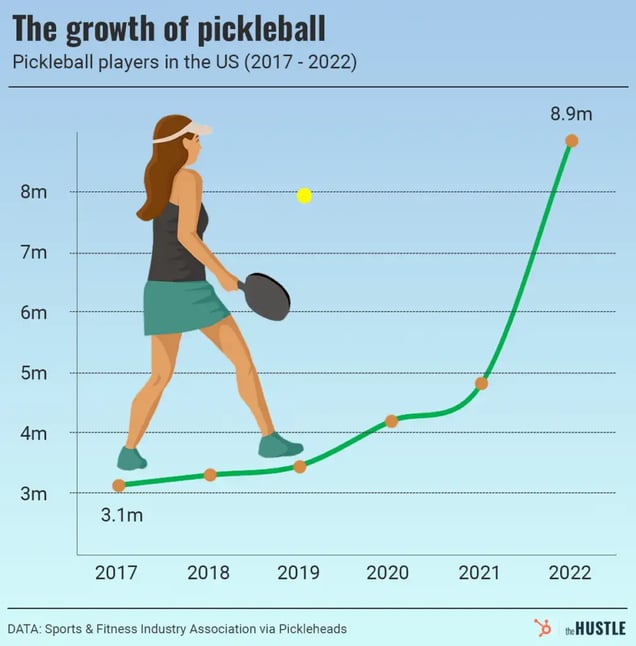
But keeping future courts at a distance has become tougher as the sport expands out of country clubs and retirement communities into municipal parks and residential streets, where Wyerman has seen people setting up makeshift courts in driveways and cul-de-sacs.
Sound barriers in these situations are either impractical or cost prohibitive. For pickleball to be a welcome — or at least tolerable — addition to a neighborhood, the equipment will have to be quieter, too.
The push for new standards
On a late May afternoon, Unetich is winding down at his “lab,” i.e., two cluttered storage rooms in a retrofitted office building in the South Hills outside Pittsburgh. In the lab’s echoless sound chamber, he tests pickleball equipment, dropping balls into a tube and down to a paddle ~12 feet below and measuring the sound levels.
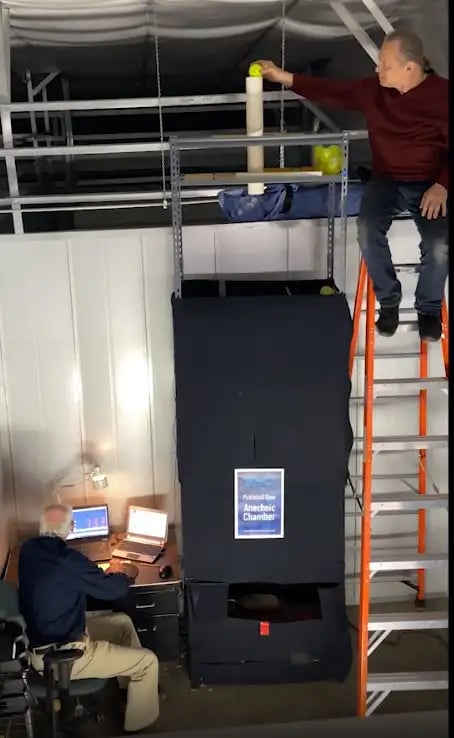
Unetich’s sound chamber. (Courtesy of Bob Unetich)
For a game that has become a phenomenon in part because of its simplicity, there is an astonishing variety of pickleball paddles and balls on the market. USA Pickleball has approved more than 1.9k paddles and 114 balls, according to its own data.
The approval process is contingent on characteristics like weight for balls and surface roughness and size for paddles. The words “sound,” “decibels,” and “noise” don’t even appear in USA Pickleball’s equipment standards manual.
But Unetich has studied the noise levels for dozens of paddles and balls.
- He found that using softer plastic balls can drop 1-3 dBA from the average sound of a pickleball match, and thinks that one day someone may invent a quieter ball that approximates the same bounce as plastic (foam balls, which are available, drastically change the feel of the game).
- He also found that thicker paddles with softer faces can be up to 7 dBA quieter than typical models, and put together a list recommending more than a dozen paddles with frequencies lower than 1k Hz.

Pickleball paddles with a surface made from graphite, a common material in addition to fiberglass. (Wikimedia Commons)
High-level players tend to prefer the softer-faced, thicker paddles, which are better for spin, according to Unetich. But average pickleballers tend to buy the cheap models that also happen to be the loudest. On top of that, he said, paddle manufacturers focus most on power and control, neither of which brings sound levels down.
To incentivize the production of quieter equipment, Unetich has held discussions with USA Pickleball about paddles and is hopeful the organization will approve a family of paddles for recreational players featuring standards for noise levels and pitch. (USA Pickleball did not respond to an interview request.)
Unetich recognizes that noise is unlikely to put too much of a damper on pickleball’s US growth. But what will happen if the sport’s popularity continues to grow around the world? He’s already had one client in Amsterdam, and got to thinking about all the density and open windows in summertime in European and Asian cities.
“You put pickleball there,” he said, “it’s going to be a problem.”
Sports And Esports


